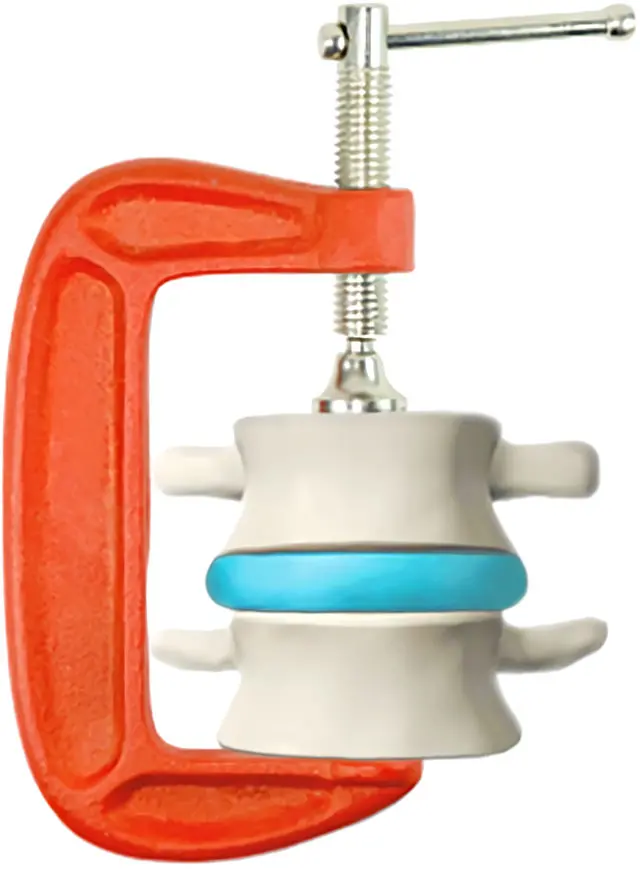Discopathy – herniated disc and Atlas
TURN ON THE AUDIO PLAYER
A herniated disc refers to the displacement of a portion of the nucleus pulposus of the intervertebral disc, the cushion located between two vertebrae. The displaced portion of the nucleus may compress nerve endings, creating a mechanical conflict that leads to numbness in the limbs.
Intervertebral discs, in addition to providing flexibility to the spine, act as shock absorbers to absorb stress. They are capable of withstanding extremely high loads, provided that the force is distributed evenly across the entire surface of the disc and that it has not degenerated. For example, lifting a 10 kg object with outstretched arms can exert a load of up to 800 kg on the intervertebral discs.
Thanks to the systematic documentation of the posture of each person treated, using a specific postural measurement system, we at AtlantoMed can assert with certainty that a herniated disc, whether lumbar or cervical, is always associated with a significant pre-existing postural imbalance. This imbalance manifests through a noticeable pelvic misalignment, a chronic lateral deviation of the spine (scoliosis) or, in the case of the cervical spine, an altered curvature.
In medicine, people often talk about "worn-out" intervertebral discs. But have you ever wondered how they could wear out and why that should happen? Perhaps they are compared to car shock absorbers, which deteriorate after a certain number of kilometers. If this were true, it would mean that, to preserve our discs, we should limit our movements as much as possible. However, experience shows the opposite: those who practice sports, despite putting more stress on their intervertebral discs, maintain them in excellent health.
The truth is that intervertebral discs do not wear out like mechanical objects; instead, they undergo a degenerative process that gradually reduces their volume, eventually leading to the rupture of the outer fibrous ring. But why does this happen? The answer lies in unbalanced stress: when discs are constantly loaded on one side and subjected to excessive compression by chronically tense muscles, they eventually give way, much like a dam under pressure. Think of a sandwich filled with mayonnaise—if you press it too hard, the mayonnaise squeezes out from the sides; the same thing happens to intervertebral discs.
Discs can and must be subjected to loads to stay healthy, but the stress must alternate with moments of release; constant pressure is harmful! We can compare them to piano keys: when you press them in sequence, they produce a melody, but if you keep them constantly pressed, the piano stops playing.
In medicine, the principle of cause and effect is often reversed, turning a herniated disc from a consequence into the root cause of the problem. The poor intervertebral disc, constantly compressed like in a vice, shifts from being a victim of unfavorable circumstances to being considered the source of all ailments. The theory that the hernia is the cause of pain does not explain why, after surgical removal of the hernia, in many cases the pain persists or even worsens due to additional damage to the surrounding tissues and post-operative scarring. Moreover, the problem often recurs over time. The failure rate is so high that recently even surgeons have started to question whether the scalpel is really the right solution in 95% of cases.
How does a discopathy or a herniated disc develop?

Anatomy of an inevitable herniated disc: if your pelvis is tilted or you suffer from scoliosis, the vertebrae do not distribute weight evenly across the entire surface of the disc but concentrate it on one part. The situation worsens further in the presence of other spinal abnormalities.
The consequences are easy to imagine: over time, the area of the intervertebral disc that bears the constant pressure deteriorates, creating the conditions for a disc protrusion or herniation.
Persistent excessive muscle tension caused by poor posture compresses the vertebrae and severely limits the range of motion of the intervertebral disc in between. As constant pressure on the disc increases, the spine becomes progressively stiffer and less flexible.
To remain healthy and functional, intervertebral discs must be able to exchange nutrients and waste products with the surrounding tissues. This process occurs through pressure changes generated by the compression and decompression of the disc during vertebral movement. The nourishment of the disc depends entirely on this mechanism, as intervertebral discs cannot be vascularized like other tissues, simply because the intradiscal pressure is much higher than blood pressure.
The pressure exerted on intervertebral discs also varies depending on the body's position. When moving from a standing position to a lying position, the load on the discs is reduced by only 20%, contrary to what one might expect. Under optimal conditions, this load reduction, combined with occasional movements during the night, should allow the discs to regenerate, to the extent that in the morning the spine is longer—a sign that the discs have regained volume. However, under the unfavorable conditions described earlier, the already limited load reduction margin decreases drastically, compromising the crucial regenerative phase that occurs during sleep.
Over the years, intervertebral discs tend to "dehydrate" and lose elasticity. This makes them more fragile, so that even a moderate load could cause them to rupture.
What to Do Against a Discopathy?
It is possible to surgically remove the damaged portion of the disc. The displaced pulp exerts pressure on the nerve roots emerging from the spine, causing pain and paresthesia in the limbs. Nowadays, alternative solutions are preferred because these types of operations are not risk-free; they can lead to complications and chronic pain, as reported by many people.
The surgical solution certainly does not address the primary cause of poor posture, which means that the situation may deteriorate into new herniated discs in the future. Why not tackle the problem at its root? And by root, we do not mean the nerve root compressed by the hernia, but rather the underlying cause of the postural imbalance.
In the absence of other interfering factors, the repositioning of the Atlas induces the leveling of the pelvis and the restoration of proper posture. A correct distribution of the loads on the intervertebral discs and the reduction of muscle contractures significantly promote the spontaneous resolution of the hernia and reduce the risk of future herniations.
The correction of the Atlas is particularly recommended for the prevention of herniated discs and in cases of disc protrusion.
We also recommend that you learn more about the non-invasive SPINEMED treatment.
Remember: to repair a punctured tire, you must first plug the hole and then inflate the wheel. Reversing the order or performing only one of the two steps inevitably leads to failure.
Video Interviews on Herniated Disc
testimonials after Atlas realignment
Some Testimonials from the Forum
- Fralic: Discopathy: goodbye to lumbar block
- Adelante: Improvement for my herniated discs
- Lolito: No more pain from herniated disc – I am reborn
- Patrizia: Herniated disc resolved
- Other testimonials: protrusions – herniated disc – discopathy
What People Say About Us
Beware of those who disguise a simple cervical manipulation as Atlas realignment and those who offer low-quality imitations of our method. The results speak for themselves: over 10,000 testimonials and reviews in various languages make us unique. Click to discover opinions, ratings, and authentic experiences shared by those who have experienced Atlas correction with Vibro-Resonance AtlantoMed:



